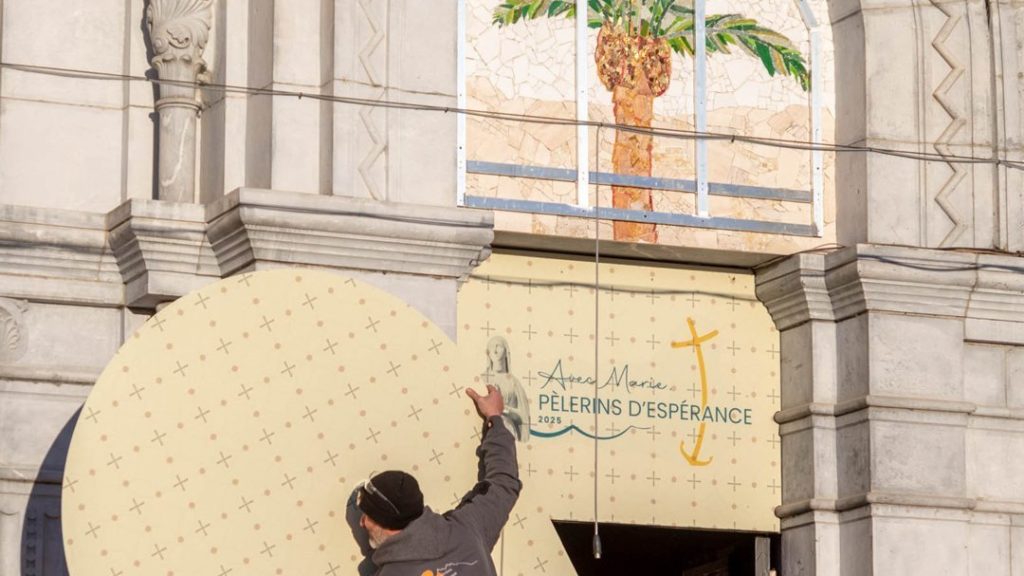As dioceses and shrines are questioning how best to limit the use of artwork created by Slovenian Father Marko Rupnik, who is accused of sexual, spiritual and psychological abuse over three decades, the art center he founded continued to promote his latest mosaics at the Sanctuary of Our Lady of Aparecida in Brazil.
In a post on its Instagram page shared April 4, the Centro Aletti said that over the coming days, it would feature "100+ images of the South facade and colonnade" of the Marian shrine on its website.
Father Rupnik, 70, was briefly excommunicated by the church in 2020 for absolving an Italian novice with whom he had sex. The excommunication was lifted after he repented.
The Jesuits disclosed in December 2022 that it had suspended the Slovenian artist after allegations of abuse had surfaced. In June 2023, Father Rupnik was expelled from the Jesuits for refusing to obey restrictions imposed upon him related to the sexual, spiritual and psychological abuse of some two dozen women and at least one man over the course of 30 years.
On the sidelines of a book presentation March 21, Cardinal Víctor Manuel Fernández, prefect of the Dicastery for the Doctrine of the Faith, told journalists that preparations were underway for a canonical trial against Father Rupnik.
Nevertheless, despite the fact that the allegations against the priest were deemed credible as early as May 2019, the Centro Aletti continued to not only promote Father Rupnik's artwork, but also his spiritual writings. In a recent post published April 7, the art center promoted a new e-book written by the priest titled, "In the Fire of the Burning Bush: An Initiation to the Spiritual Life."
The alleged victims of Father Rupnik have called for the removal of the priest’s artwork, saying it is a painful reminder of the abuse they suffered. One of his victims, Sister Samuelle, said she was abused while they were installing a mosaic.
A number of shrines that featured his work have taken steps to either cover or limit the public display and use of Father Rupnik's artwork since the abuse revelations were made public. The Basilica of Our Lady of the Rosary in the Sanctuary of Our Lady of Lourdes, France and the St. John Paul II National Shrine in Washington, D.C. opted to cover the mosaics out of respect for his victims. The Shrine of Our Lady of Fatima in Portugal, which features a mosaic made by Father Rupnik behind the main altar of the Basilica of the Holy Trinity, said that while it is not considering removing his artwork, it has "suspended the use of the image, the entirety of the work, and its details in our promotional materials."
But the Shrine of Our Lady of Aparecida in Brazil, which features the Slovenian priest's largest mosaic to date, measuring 43,000 square feet, went ahead with its installation despite calls for the shrine to reconsider given the serious allegations.
Announcing the decision to cover Father Rupnik's mosaic at the Lourdes shrine, Bishop Jean-Marc Micas of Tarbes and Lourdes said covering the controversial artwork aimed to make the shrine a more welcoming place, particularly for victims of abuse.
"I felt, along with my colleagues, that a new symbolic step had to be taken to facilitate entry into the basilica for all those who are currently unable to cross the threshold. As a result, all the doors to the Basilica of (Our Lady of) the Rosary have been modified," Bishop Micas said in an interview released by the sanctuary March 31.
Victims and survivors, especially Father Rupnik's alleged victims, hailed the decision as a concrete act of support for those who have suffered greatly from clerical sexual abuse.
Antonia Sobocki, Catholic director of the British-based LOUDFence organization, a survivor-led group supporting survivors and promoting safeguarding, announced that the group has joined with the Diocese of Plymouth to launch a Jubilee Year campaign titled, "Pilgrims of Healing and Hope."
In her announcement posted on X April 7, Sobocki expressed gratitude to Bishop Micas and the Lourdes commission in prioritizing abuse survivors by covering Father Rupnik's mosaics.
"This means those who found passing through the doors of Lourdes, past Marko Rupnik's mosaics, was just too traumatic, may now pass unhindered," she wrote.
She asked all pilgrims visiting Lourdes to "take a photo of themselves in front of the covered doors of the Rosary Chapel and then post the images online with the hashtags #PilgrimsOfHopeAndHealing and #IWillNotForsakeYou."
In a statement sent to OSV News April 7, Sobocki said the decision by Bishop Micas to cover Father Rupnik's mosaics "was news I longed for on behalf of victims/survivors."
Upon receiving several messages on her phone about the decision, Sobocki told OSV News that it took "a few moments for the enormity of what the message was saying to finally sink in."
"Then I started to cry and I couldn't stop," she said. "It's as if all the stories of harm which I carried around with me finally burst through a floodgate. I thought of all the people who had confided their experiences of harm and loss through abuse to me. It felt as if Bishop Jean-Marc Micas and the commission in Lourdes had personally listened to all of them, seen them and prioritized them."
Sobocki said she received messages from many survivors who shared the "same sense of elation" for what she described as "an act of deliberate care for survivors" in spite of the fact that Bishop Micas and the Lourdes Commission's decision to cover the artwork was "met with significant resistance."
"I know this act of mercy was given freely, and although it is absolutely the right thing to do, it requires them to side with the powerless and marginalized against powerful people with a lot of influence and resources," she said.
Regarding the Holy Year campaign with the Diocese of Plymouth, Sobocki told OSV News it was designed to "let survivors and those who advocate for them in Lourdes know they are not alone."
"It has become policy in many dioceses to not have diocesan pilgrimage photos in front of the main doors of the Rosary Chapel in order to avoid being photographed with Rupnik's mosaic but now the mosaics are covered we thought it would be possible to do the reverse to affirm Bishop Jean-Marc's act of mercy," she said.
The campaign, she added, enables pilgrims to show support for Father Rupnik's victims, "as well as the millions of other survivors around the world. It is a wonderful act of affirmation and care for the wounded."
"From the ashes of grief and despair, I believe it is possible to be resurrected to hope and healing," Sobocki said.

